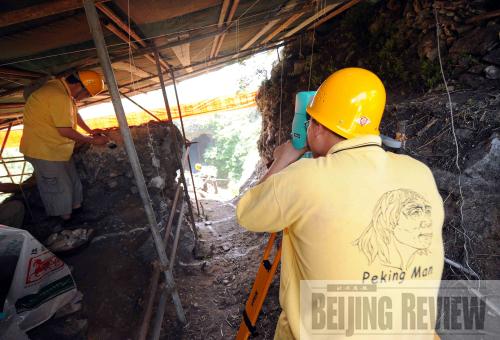|
 |
|
FURTHER EXPLORATION: Archaeologists work on the Peking Man site at Zhoukoudian. A large-scale protective excavation was carried on the site on June 24 (LUO XIAOGUANG) |
In 2001, Shen, cooperating with American colleagues, used a new uranium series method that appeared in the 1990s to determine that the ages of the first to second layers of the site of Zhoukoudian were 400,000 years old and the error was only 10,000 years. However, the method reached its limits when testing the fifth layer.
"The upper limit of the uranium series method is only 600,000 years because uranium is an element with a short decay period," Shen said.
Shen had run out of ideas to age the samples more accurately when he saw an article by Darryl Granger in the journal Science in 2003. Granger suggested a method to determine the age of quartz sands, which are common in Zhoukoudian, Shen said.
"When cosmic rays strike the surface of the Earth, they separate silicon and oxygen atoms out of the quartz, which become the isotopes of aluminum and beryllium," Shen said. Under normal conditions, the proportion of 26Al and 10Be in quartz sands on the surface of the Earth is 6.8, but when the quartz sands are buried underground, the two isotopes stop increasing and start disintegrating. However, the decaying speeds of the two isotopes are different. 26Al is faster than 10Be and their proportion will reduce 50 percent in 1.5 million years. That means the proportion will be 3.4 from the original 6.8 after 1.5 million years. With the tiny change, scientists can calculate the time quartz was buried underground and determine its age by using large-scale equipment called an accelerator mass spectrometer to accurately test the quantities of the two isotopes.
In 2004, Shen and Granger began cooperating and used Granger's method.
According to the experimental procedures, coarse sands need be put into a plastic bottle full of hydrofluoric acid and tumbled and heated for a long time. After several weeks, most of the impurities will be dissolved and then, using heavy liquid separation, there will be 0.2-0.9 mm of quartz sands.
Before they are considered final samples, these sands are tested magnetically, said Shen. He used an ordinary magnet taken from a trumpet to pull away magnetic substances from the quartz sands.
After that, he sent the first group of three samples to Granger but got a disappointing answer—the samples were not pure enough. "What we wanted to test was 26Al but there was too much 27Al in the samples," Shen said.
Hence, he decided to pick samples by hand. He fixed several fluorescent tubes into a drawer and covered the drawer with a piece of ground glass as a lens. "Those translucent and colorless sands contain less 27Al," he said.
Finally, Shen sent six samples of quartz sands and four quartzite stone samples from the seventh to 10th layers of the Zhoukoudian site to the laboratory in the United States and six of them were judged to be useful. After testing the six samples, scientists determined that Peking Man lived 770,000 years ago, with an uncertainty ranging 80,000 years in either direction.
Ice age
"In paleoanthropology research, 200,000-300,000 years is not an astonishing time frame for errors but it is highly significant to Homo erectus," said Gao.
Peking Man is still the most well-known example of Homo erectus in the world. Paleoanthropologist Russell Ciochon, a University of Idaho professor in the United States, said the 270,000-year advancement in the existence of Peking Man pushes the creature into a much colder age. The Earth 770,000 years ago was in the middle of an ice age.
Fossil remains are mostly found in warm areas around the globe, such as South Africa, east Africa, Indonesia's Java Island and south China, but Zhoukoudian lies in the northern extent of east Asia. Although Peking Man has long been considered a cold-resistant example of human ancestors 400,000-500,000 years ago was much more mild in terms of climate, which meant that it was warmer and the food was more abundant.
Shen's new conclusion changes researchers' perception of Peking Man's living conditions. Hence, Granger said paleoanthropologists should reconsider the vitality and adaptability to environments of human progenitors.
Fire would have been necessary for Peking Man to survive. Some experts believe that the new discovery will advance science's understanding of when fire was used.
"Don't look down upon such simple social activities," said Gao. He also said colony formation was important to human ancestors and it was their simple social activities that helped them survive.
Like other discoveries, the new conclusions about Peking Man's age also aroused a hot debate. Wu Xinzhi, an academician with the Institute of Vertebrate Paleontology and Paleoanthropology at the Chinese Academy of Sciences, suggested carefully considering the movement of quartz sands. Guo Shilun, a researcher with the China Institute of Atomic Energy, also suggested reconfirming if the layers of quartz sands could present the age of older quartz entering the layers.
Shen admitted that many techniques, including what he used, needed to be improved because their accuracy is not perfect. But he believed that the development of new equipment and technologies in the next 10 years could improve the accuracy to within 40,000 years. | 